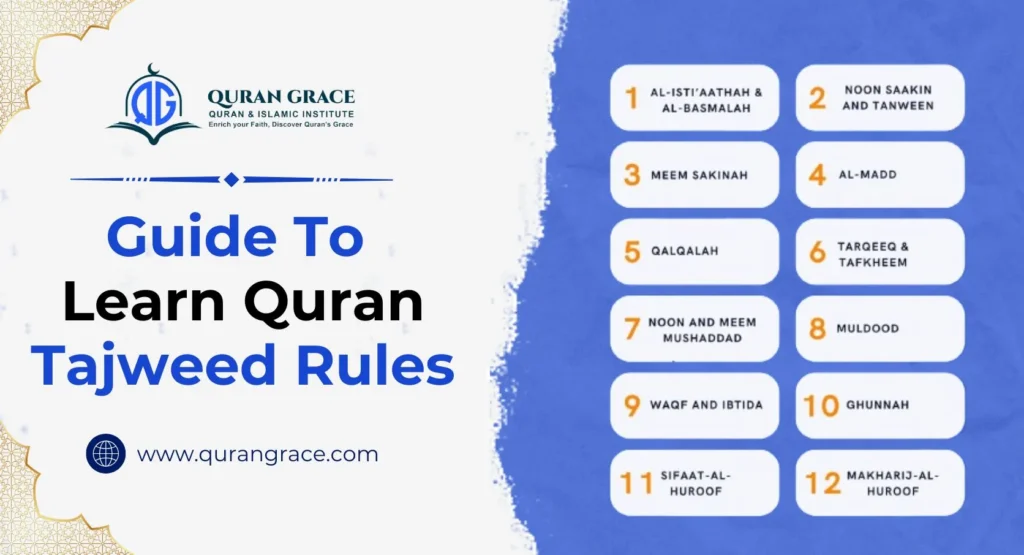The Quran is a divine revelation, a source of guidance, and a spiritual sanctuary. While translations can convey their meanings, truly connecting with its profound message often requires understanding it in its original language: Quranic Arabic.
Learning Quranic Arabic can seem like a daunting task, but with the right approach, dedication, and resources—such as enrolling in a structured Quranic Arabic course—it becomes an enriching and transformative journey. You need to start learning the basics, build a strong vocabulary bank, understand essential grammar, take help from a professional tutor, and begin practising small Arabic phrases. This comprehensive guide will walk you through the essential steps, strategies, and tips to help you embark on this beautiful linguistic and spiritual quest.
Table of Contents
Toggle5 Practical Tips to Learn Quranic Arabic
You can apply these tips step-by-step to enjoy the perks of Quranic Arabic at home. Do not forget to stay consistent and determined to reach your ultimate goals.
1. Mastering the Basics
Every linguistic journey begins with the ABCs. For Quranic Arabic, this means the Arabic script and basic phonetics.
- Learn the Arabic Alphabet (Huruf al-Hijaiyah):
Familiarize yourself with the 28 letters of the Arabic alphabet. Pay attention to their isolated forms, as they change slightly when connected within words. This is crucial. Arabic has sounds that might not exist in your native language. Listen carefully to native speakers or reputable teachers. Focus on the correct articulation points (makharij al-huruf) for each letter.
Online tutorials, dedicated alphabet apps, and children’s Arabic learning books are excellent starting points.
- Vowels and Diacritics (Harakat):
Arabic uses short vowels (fatha, kasra, damma) represented by diacritical marks above or below the letters. Long vowels are formed by combining short vowels with specific letters (Alif, Waw, Ya). Understanding these is fundamental to reading and pronouncing words correctly.
- Tajweed (Rules of Recitation):
Tajweed refers to the rules governing the correct pronunciation of the letters and words in the Quran. It’s an art and science that ensures the Quran is recited as it was revealed. Focus on clear articulation, stopping points, and basic elongation rules.
2. Building Vocabulary and Grammar
Once you can read, the next step is to understand. This involves acquiring vocabulary and grasping grammatical structures.
- Start with High-Frequency Quranic Words:
Many words appear frequently in the Quran (e.g., Allah, Rabb, Kitab, Yaum, Samawat, Ard). Focus on these first. Instead of rote memorization, try to learn words in the context of short Quranic verses.
Utilize flashcards (physical or digital) and vocabulary-building apps specifically designed for Quranic Arabic. Dedicate a small, consistent amount of time daily to vocabulary acquisition.
- Learn Basic Quranic Grammar (Nahw and Sarf):
Deals with sentence structure, word endings (i’rab), and how words relate to each other. Focuses on word formation, verb conjugations, and how words are derived from root letters.
Don’t try to learn everything at once. Begin with identifying nouns, verbs, and particles. Understand basic sentence structure. Arabic is a root-based language. Most words are derived from a three-letter root. Learning to identify these roots will unlock a vast amount of vocabulary. For example, the root ك ت ب (k-t-b) gives us “kitab” (book), “kataba” (he wrote), “katib” (writer), and “maktab” (office/desk).
Textbooks specifically designed for Quranic Arabic grammar, online courses, and YouTube channels.
3. Follow Effective Learning Strategies
- Consistency is Key:
Little and often is far more effective than infrequent, long study sessions. Aim for 15-30 minutes daily rather than a few hours once a week.
- Immerse Yourself (to the extent possible):
Listen to Quran Recitations: Regularly listen to recitations by renowned Qaris. Pay attention to the sound and rhythm.
Watch Islamic Lectures/Dramas in Arabic (with subtitles initially): Even if you don’t understand everything, your ears will get accustomed to the sounds and flow of the language.
- Active Learning:
Practice Reading: Read short surahs (chapters) and try to identify words you’ve learned.
Practice Writing: Write out verses or vocabulary words.
Translate (Back and Forth): Translate short verses from Arabic to your native language, and then try to translate them back to Arabic. Compare with the original.
4. Find a Study Buddy or Group
Learning with others can provide motivation, opportunities for practice, and a supportive environment. You can discuss concepts, quiz each other, and practice speaking.
Utilize Technology:
- Quran Apps: Many apps offer word-by-word translations, audio recitation, and even grammar breakdowns.
- Online Dictionaries: Arabic-English dictionaries (e.g., Hans Wehr) are invaluable.
- Language Learning Apps: While not always specific to Quranic Arabic, some general apps can help with basic Arabic vocabulary.
6. Recommended Learning Path
- Phase 1: Foundation (1-3 months, depending on dedication)
- Master the Arabic alphabet and its pronunciation.
- Learn basic Tajweed rules.
- Memorize short surahs with correct pronunciation.
- Start recognizing frequently occurring words.
- Phase 2: Building Blocks (3-6 months)
- Expand your vocabulary of high-frequency Quranic words.
- Begin learning basic Arabic grammar (nouns, verbs, particles, simple sentence structures, verb roots).
- Start reading simple Quranic passages with word-by-word translation aids.
- Phase 3: Intermediate Understanding (6 months onwards)
- Deepen your understanding of Arabic grammar (e.g., different verb forms, noun cases, prepositions).
- Engage with more complex Quranic verses, attempting to understand them independently.
- Continue to refine your Tajweed.
- Start reading simplified Tafsir (Quranic exegesis) in Arabic.
7. Seeking Guidance: The Role of a Teacher
While self-study is commendable, having a qualified teacher (or Ustadha/Sheikh) is invaluable, especially for Quranic Arabic.
- Correction of Pronunciation: A teacher can instantly correct your Tajweed and Makharij.
- Clarification of Grammar: Complex grammatical rules become much clearer with an expert explanation.
- Motivation and Accountability: A teacher provides structure and keeps you motivated.
- Personalized Feedback: They can identify your weaknesses and tailor their teaching to your needs.
Don’t be afraid to seek out local Islamic centers, mosques, or reputable online platforms that offer Quranic Arabic classes.
Why Learn Quranic Arabic?
You must know why to learn Quranic Arabic.
- Deeper Understanding: Translations, no matter how good, can never fully capture the nuances, eloquence, and miraculous nature of the Quran’s original text. Learning Arabic allows you to grasp the layers of meaning, the power of its rhetoric, and the beauty of its composition directly.
- Enhanced Prayer and Connection: Imagine understanding every word you recite in your daily prayers (Salat). This deepens your khushu’ (devotion) and fosters a more profound connection with Allah (SWT).
- Access to Islamic Heritage: The vast majority of classical Islamic scholarship, hadith, tafsir (exegesis), and jurisprudence is in Arabic. Learning the language opens up a treasure trove of knowledge and allows you to engage directly with the intellectual legacy of Islam.
- Spiritual Growth: The journey of learning the language of the Quran is inherently a spiritual one, fostering discipline, patience, and a deeper appreciation for the divine word.
Conclusion
Learning Quranic Arabic is a journey of profound discovery, a bridge to deeper understanding, and a source of immense spiritual reward. Follow all the tips to learn the Arabic of the Quran efficiently. Start with small, consistent steps, be patient with yourself, seek out good resources and teachers, and most importantly, make sincere du’a (prayer) for success. May Allah (SWT) make this journey easy and beneficial for you. You can also enrol in an online course by Quran Grace where the professional Arabic tutor will help you understand Quran step-by-step in online quran recitation classes!








